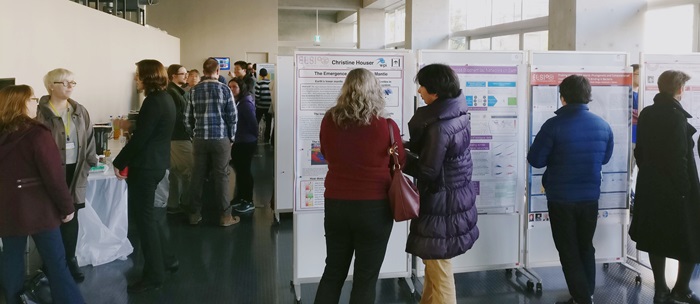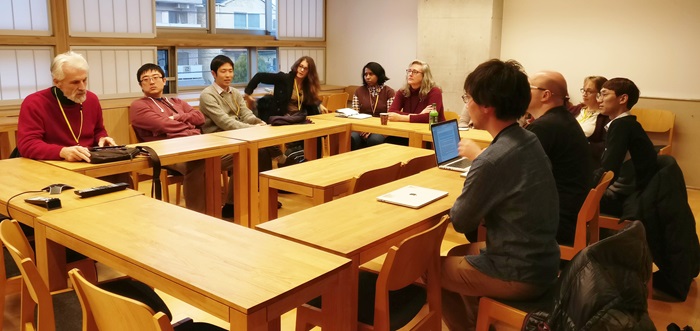#ELSI2019 Symposium Day 1
Blog No.146
Author: Marc Kaufman

Pour yourself some Beefeater's gin and take a drink. For most people, not so good.
Or pour yourself some tonic water and take a drink. Again, not so good.
Put them together and add some lime, and you have a gin and tonic. Often quite good.
This was the first simple example of "emergence" described at the 7th Earth-Life Science Institute symposium on "Comparative Emergence."
It's a gathering of scientists who work with - or are interested in learning about -- the concept of emergence in their many disciplines. It's organized as well around the proposition that emergence could, and perhaps should, be a more broadly-used scientific concept. Thus the introduction of the subject of comparative emergence.
Emergence is a broad term, one that can describe many phenomena and processes in fields from astrophysics to pre-biotic chemistry, from the origin of life to the development of language, and from philosophy to the rise of consciousness.
Most simply, it refers to the transformation of simplicity in its myriad forms to a greater complexity that exhibits novel characteristics not present in the component parts.
As symposium science lead John Hernlund put it before the meeting, researchers working on the specifics of their own field may be aware of emergence in particular spheres, but not of emergence as a more general concept.

A primary goal of the symposium, he said, is to zoom out to a broader view where, he and ELSI colleagues believe, scientists may well find that the nature, the logic, the dynamics of specific instances of emergence have a great deal more in common than first imagined.
This zooming out and bringing together is not only a potentially useful research tool, Hernlund said, but it is also an essential goal at ELSI. The Institute's existence is grounded in the idea that scientists are more capable of tackling the big questions when they work together to seek intellectual synergy, rather than working separately as specialists in their disciplinary domains.
With this in mind, comparative emergence becomes a kind of scientific pathway to greater connections between disciplines, or perhaps a high-level glue that binds them together.
A premier example of emergence was provided by cosmologist Katie Mack of North Carolina State University. Starting with the Big Bang and the inflation of the universe understood to have occurred fractions of a second afterwards, she traced the pathway of the evolving components that would become our universe.
It was, Mack said, a primordial soup of almost complete similarity and temperature that had only miniscule quantuum fluctuations to produce any diversity. Over billions of years that diversity was shaped by gravity and other forces and eventually produced stars, planets, galaxies and eventually the web of matter we now know makes up the universe.
Mack said that the concept of emergence does not loom large in her field, but that the process described is clearly going from simple to complex, and from the presence of certain characteristics to the presence of other novel ones.
Takayuki Saitoh of Earth-Life Science Institute traced the related path of the development of the elements and chemistry of the universe. And again, he spoke of the transformation of the simple into novel, complex new forms.
The day's first speaker was Takashi Ikegami of the University of Tokyo and a prominent figure in the field of artificial life (A-Life, ) where researchers examine systems related to natural life, its processes, and its evolution, through the use of simulations with computer models, robotics and biochemistry.
He has spent two decades studying what he calls "open-ended evolution," or the constant rise of novel characteristics in various domains - all through simulations.
To begin to understand emergence, he said, is to begin to understand open-ended evolution and the constant self-organization, or re-organization, that drives it.
A-Life researchers have long looked to the swarming behavior of some birds as a tool to explore ideas of emergence. While the size, wingspan, speed and other characteristics of the birds can be quantified, the swarms they create and the wild patterns of their group flights cannot to translated into math and physics. It is an "emergent phenomenon," and a strong one at that.
In the history of emergence, a differentiation has been made between "strong" emergence which cannot be predicted and "weak" emergence that can. Put another way, strong emergence cannot be understood by reducing or deducing the component parts from, the properties of the components of that new system. With weak emergence, the creator of a newly commplex system won't necessarily be surprised.
A surprising solution to solving the Rubik's cube puzzle also provided an insight into emergence, Takashi said. Using formulas and calculations and visualizations of the cube, researchers had concluded that the minimum number of steps possible to solve the puzzle was 22. But eight ago a collection of idle Google computers set to work on the puzzle and solved it in 20 moves - something that still hasn't been understood by humans.
Takashi didn't specifically discuss this during his talk, but he later described his work on creating an "android" robot, one that can make decisions to move, frown, pick something up on its own. He hopes to give it the equivalent of a human awareness and ability to grow that would entail a kind of open-ended evolution.
The symposium will continue three more days, with sessions on the "Emergence of Planetary Complexity," the "Emergence of Organic Chemical Complexity," the "Emergence of Life," the "Emergence of Communication" and the "Emergence of Emergence."
After each day's sessions, symposium attendees gather in smaller groups to discuss emergence in their fields -- the parallels and differences that might be present. Their discussions will become part of a report on conclusions after the meeting finishes.
The symposium will end with a panel discussion led by Mary Voytek, ELSI Executive Director and head of NASA's astrobiology program. The panel will include former NASA/Library of Congress Baruch Blumberg Astrobiology Chair and historian of science Luis Campos of the University of New Mexico, geochemist Karyn Rogers of Rensselaer Polytechnic Institute and theoretical physicist and astrobiologist Sara Walker of Arizona State University.
